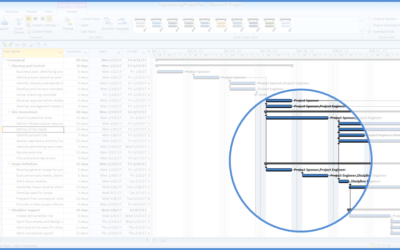Microsoft Project: Expert
Microsoft Project Training Series | Level 3
Course Details
Duration: 1 day (9 am – 4 pm)
Microsoft® Project® Versions: 2013 | 2016 | 2019 | 365 (Desktop)
Delivery Methods: Instructor-led classroom (ILC) | Virtual classroom (VC) on request
Course Dates: TBA | View schedule ![]()
Course Fee: $275 CDN per person + HST (Virtual classroom), $295 CDN per person + HST (Bring your own device for live classroom courses) or $345 CDN per person + HST (Avantix Learning provides device for live classroom courses)*
Timing: Public scheduled courses run from 9:00 am to 4:00 pm (Eastern Time).
Virtual classroom courses: Our instructor-led virtual classroom courses are delivered in a virtual classroom environment. Students will be sent a virtual classroom invitation prior to the course.
Live classroom courses: Our instructor-led live classroom (in-person) courses are held in downtown Toronto at the Toronto Star Building, 1 Yonge Street, Suite 1801. Some courses are also held at an alternate downtown Toronto location.
Custom training: This course may be delivered at your site or ours as an instructor-led or virtual classroom solution. Contact us at info@avantixlearning.ca for more information including savings for custom group training.
Course Overview
During this instructor-led Microsoft Project course, students will move to the next level with Project. Data will be imported from and exported to Excel. Custom forms will be designed and copied to other projects similar to other custom objects. Work breakdown schedules will be created and progress will be forecasted using Earned Value Analysis. Students will learn to manage multiple projects as well as resource pools. At the end of the day, students will create simple macros to automate Microsoft Project. Throughout this course, the instructor will include numerous tips, tricks and shortcuts.
Prerequisite: Microsoft Project: Intermediate or equivalent knowledge and skills.
Custom training: This course may be delivered at your site or ours as an instructor-led or virtual classroom solution. Contact us at info@avantixlearning.ca for more information including savings for custom group training.
Related training: View all Microsoft Project courses >
INCLUDED IN THIS COURSE
- Comprehensive course manual or published book
- Keyboard shortcuts quick reference
- Sample and exercise files
- Refreshments (for classes conducted in Avantix Learning classrooms)
- Certificate of completion
- Follow-up email support
Course Topics
Creating Custom Forms
- Displaying forms
- Creating a custom form
- Adding items to a form
- Copying forms between projects
Creating Work Breakdown Schedules
- Setting up work breakdown schedules
- Displaying work breakdown schedules
- Hiding work breakdown schedules
Excel Importing and Exporting
- Importing from Excel
- Exporting to Excel
- Creating import/export maps
- Linking between Microsoft Project and Excel
Managing Multiple Projects
- Working with workspaces
- Consolidating projects
- Hiding and unhiding windows
- Creating links across projects
- Saving consolidated project baselines
Managing Resource Pools
- Sharing resource pools
- Turning off resource sharing
- Identifying resource pool links
- Protecting a resource pool
- Updating a resource pool
Reviewing Progress using Earned Value Analysis
- Overview of Earned Value Analysis (EVA)
- Working with earned value fields, tables and reports
- Reviewing forecast variances
- Exporting earned value data to Excel
Getting Started with Macros
- Using VBA (Visual Basic for Applications) to automate Microsoft Project
- Creating a simple VBA macro
- Running a VBA macro
. *Prices subject to change.
Our instructor-led courses are delivered in virtual classroom format or at our downtown Toronto location at 18 King Street East, Suite 1400, Toronto, Ontario, Canada (some in-person classroom courses may also be delivered at an alternate downtown Toronto location). Contact us at info@avantixlearning.ca if you'd like to arrange custom instructor-led virtual classroom or onsite training on a date that's convenient for you.
Copyright 2024 Avantix® Learning

Custom training
Register now for a public scheduled course or contact us to discuss custom on-site or off-site training options.
Related courses
Microsoft Project: Intermediate / Advanced
Microsoft Project: Generating Reports
Microsoft Project: VBA (Visual Basic for Applications) Macros | Introduction
Microsoft Access: Introduction
You may like
7 Microsoft Project Navigation and Selection Shortcuts in Task Lists
If you are working in Gantt Chart view, you can use these keyboard shortcuts to quickly move and select in your task list.
10 Microsoft Project Shortcuts to Zoom and Move Quickly in the Gantt Chart Timescale
Zoom in, out and move using these great shortcuts in the Microsoft Project Gantt Chart timescale. The timescale in the Gantt Chart view appears on the right side and displays units of time.
Auto vs Manual Scheduling in Microsoft Project
In newer versions of Microsoft Project, you have the option of scheduling tasks using manual or auto scheduling. In earlier versions, Microsoft Project used auto scheduling which takes advantage of Project's scheduling engine to schedule tasks.
How to Create a Timeline in Microsoft Project
Timelines are a great way to view key tasks and milestones in a project. You can add tasks to a timeline and then format it any way you'd like. Copy a timeline into an email or Word or PowerPoint file to present the timeline.
You may also like
How to Insert or Type I with an Accent Mark in Word (Í, í, Ì, ì, Î, î, Ï, or ï)
You can insert or type i with an accent mark in Word using built-in tools or keyboard shortcuts (including Alt code shortcuts). The letter i can be inserted with an accent in both upper or lower case. The following are common accented characters that you can insert or type in Word in upper or lower case: grave (Ì or ì), acute (Í or í), circumflex (Î or î) and umlaut (Ï or ï).
How to Insert or Type A with an Accent Mark in Word (À, Á, Â, Ä, à, á, â, or ä)
You can insert or type a with an accent mark in Word using built-in tools or keyboard shortcuts (including Alt code shortcuts). The letter a can be inserted with an accent in both upper or lower case. The following are common accented characters that you can insert or type in Word in upper or lower case: grave (À or à), acute (Á or á), circumflex (Â or â) and umlaut (Ä or ä).
10 Word Shortcuts to Select Text Using a Keyboard
You can use several shortcuts in Word to select text in your documents using only your keyboard. When you select text, it will typically be highlighted in grey. After you select text, you can cut, copy, or delete the selected text or apply character or paragraph formatting.
Microsoft, the Microsoft logo, Microsoft Office and related Microsoft applications and logos are registered trademarks of Microsoft Corporation in Canada, US and other countries. All other trademarks are the property of the registered owners.
Avantix Learning |18 King Street East, Suite 1400, Toronto, Ontario, Canada M5C 1C4 | Contact us at info@avantixlearning.ca







